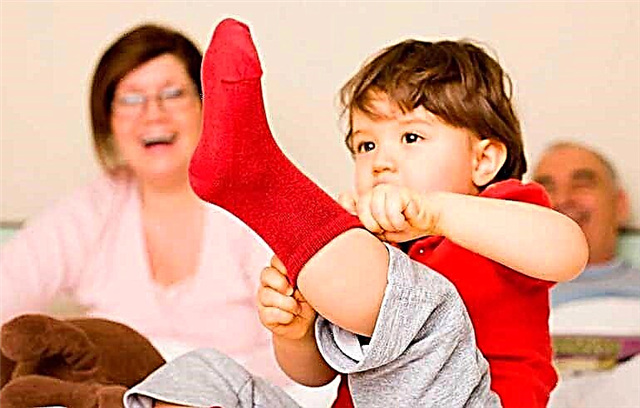Every woman who is breastfeeding sooner or later faces the question of how to wean a baby from breastfeeding. In some cases this happens ahead of schedule (for one reason or another), in others it is a natural end of the process, which also requires a special approach. This article will discuss how and when to wean your baby from breastfeeding.

Breastfeeding is an essential part of a normal baby's growth and development
How to wean a child from HB
If a woman decides to wean the baby from the breast, then in this case it is necessary to be guided by the following criteria:
- Own desires and feelings;
- Baby's condition;
- Life circumstances.
Optimal age for weaning
Before weaning a one-year-old baby, you need to figure out the best time to do it. According to the WHO recommendations, it is imperative to breastfeed a baby until the moment when he is six months old. Then you can refuse GV or continue the process up to 2 years and further, if this state of affairs suits both the mother and the child.
On a note. According to the authoritative pediatrician, Dr. Komarovsky, if a woman starts breastfeeding, then it should be continued until a year, then - at will.
There are cases when lactation for one reason or another ends earlier or later than the generally accepted time frame.
To make weaning painless, it is important to be able to tell when the child is ready to end the GW. Since children are most often negative about dramatic changes in their lives, then, most likely, the child will not be happy about weaning. It is necessary to observe the baby:
- How much does he consume from regular food, and what he likes best;
- Does he show interest in "adult" food;
- Can sleep without breast;
- Whether applied during or after the game.
It is recommended to observe the child's behavior 2 months before the planned weaning. The information obtained will allow you to draw up a clear plan for completing lactation.
Important! You can not wean a baby from GW during big family events. It can be moving, getting a job, a serious illness, or teething.
Weaning up to 1 year
Weaning a baby at the age of less than 1 year is much more difficult than at the age of 18 months - stress for the baby is inevitable. Emotional stress increases if a mother experiences excitement during this period, worries about the fact that she is depriving her son or daughter of such a desired "dish". As a result, the process of completing lactation only becomes more difficult. Mom thinks that, ceasing to give the baby a breast, she will love him less. In fact, this is not the case. The child should be weaned from GW persistently and consistently, while continuing to give him your love and warmth.
On a note. It is believed that the age of 12 months is the most suitable for weaning. By this time, most of the children are already eating "adult" food, begin to gnaw on solid food, drink formula milk from a bottle. In addition, one-year-old babies are much more active than newborn babies and, unlike the latter, do not lie all day waiting for breast milk.

Weaning a baby is a difficult process.
To complete lactation painlessly, you need to adhere to the following sequence of actions:
- Remove intermediate breastfeeding, leaving only breakfast, lunch, dinner and nightly "meal". If the baby shows a desire to kiss the breast during the "after-hours" time, then the child's attention should be switched to something else;
- Remove GW in the daytime. Most often, this process serves as a way to lay the baby. Now it would be better to replace it with reading books, lullabies, motion sickness. Also, a good option is to provide your baby with a daytime sleep in a stroller on the street;
- Remove GW during breakfast. As soon as the child wakes up, his attention needs to be switched to other activities;
- Remove GW at night. This stage is quite difficult. The main task is to teach the baby to fall asleep without breast. To calm down the child, you can give him a dummy.
- The final moment is the termination of night feedings. The last stage is the most difficult, so for its implementation it is recommended to involve not only parents, but also the rest of the family. One and a half to two weeks before weaning, you need to organize a new ritual of going to bed. It can include taking a chamomile bath, going to the potty, changing diapers, and soothing. In the first few days, the baby can be breastfed as part of a new ritual, but after a week this process must be completely eliminated. It is advisable that in the first 2-3 weeks the father put the child to sleep.
Recommendation. If you have problems with weaning, you can always seek advice from a breastfeeding consultant, while visiting a specialist is not necessary - a telephone conversation is enough.
It is necessary to move from one step to another gradually, only in this case, the cessation of lactation will turn out to be quite soft and the least traumatic. The time interval between the two stages is 2-3 weeks. If it is necessary to urgently wean the child from the breast, the transition from one stage to another should be at least 2-3 days later.
Abrupt cessation of lactation is fraught with dangerous consequences for the mother in the form of:
- Lactostasis;
- Mastitis;
- Blocked milk ducts.
For a child, such a change can turn into severe stress, disruption of the digestive system, as well as the immune system.

Mastitis in a nursing mother
Weaning from GV taking into account seasonality
The main rule of gradual cessation of lactation is to reduce the number of daily applications. Breast sucking should be replaced with other activities: reading books, playing games, visiting new places, hygiene procedures (bathing, changing diapers, cutting nails, etc.). It is necessary to diversify the child's life as much as possible, try to form a new daily routine that does not include breastfeeding. With regard to seasonality, pediatricians recommend weaning an infant from hepatitis B in spring or autumn.
Types of weaning
This article deals with permanent weaning, but there is such an option as temporary cessation of lactation. In life, there are circumstances that are incompatible with this process, for example, the need to undergo treatment in which lactation is unacceptable, to go to a hospital, to make an urgent trip, etc. In such cases, you can resort to temporary weaning.
To maintain lactation, it is necessary to express milk up to 5-6 times a day and adhere to proper nutrition.
Recommendation. If the mother is unexpectedly admitted to the hospital, it is necessary to warn the doctor that the woman is breastfeeding. Then he will pick up more gentle drugs that will not interfere with further feeding.
In addition to temporary and permanent weaning, there are also:
- Gradual. Often women refuse to feed when the baby's teeth are teething and he literally starts biting, hurting the mother.
- The preferred method for terminating lactation. This option will not harm either the woman or the child. The essence of the process lies in the fact that the woman stops offering the breast to the baby, but at the same time does not refuse him when he himself asks for it. In such cases, no specific time limits are set. The baby grows up, and gradually the need for breast milk fades into the background. This method can take from 2-3 weeks to several months. The exact time is determined by the feeding regimen, as well as the total duration of GW.
- Fast. You can resort to this method in extreme cases when it is really necessary. Abrupt cessation of lactation causes serious stress for the infant, which can negatively affect his health.
Medical method of weaning
This method is one of the most common. The woman takes special medications that contribute to the rapid and painless completion of hepatitis B. You cannot accept these funds yourself. First you need to consult your doctor. Taking medications does not relieve the mother from the need to express milk from time to time, otherwise stagnation may form. It is not necessary to express completely, it is enough to remove so much so that there is no heaviness in the chest. If mom drains milk to the last drop, the process of product formation will continue again.
Important to remember! Medicines have side effects and contraindications. From the moment you start taking the drug, the child can no longer be applied to the breast.
On a note. One of the most aggressive ways to stop lactation is to take hormonal drugs, for example, Microfollin, Norkolut.
There are also inhibitors of prolactin production. These drugs are considered the safest. These should include Dostinex and Parlodel.

Dostinex
Weaning by separation
According to Dr. Komarovsky, one of the most effective ways to stop hepatitis B is to temporarily separate the child from the mother. The doctor gives this advice: invite the grandmother for a few days to replace the baby's mother. The woman, meanwhile, can go on a weekend trip. When the mother returns, the child will most likely remember the cherished breast, then it will be necessary to hold out for only a few hours. At this time, the toddler should be constantly distracted by various activities. After 2 hours, the baby will not even remember about breast milk.
The pediatrician considers this method to be the most optimal and civilized. Before weaning, the doctor advises to gradually train the infant to sleep in his bed.
On a note. Before leaving, the mother should consult with a gynecologist on the issue of weaning from hepatitis B in this way. Most often, in such cases, the doctor prescribes a drug that will need to be taken at the time of departure to suppress lactation.
Abrupt cessation of feeding
Emergency cessation of lactation may be justified by medical indications, the need for an urgent move and other important circumstances.
Urgent weaning is mandatory if the mother has the following diseases:
- Syphilis;
- Diabetes;
- Oncology;
- Purulent mastitis;
- Tuberculosis (open form);
- The presence of HIV.
To avoid breast swelling, milk will have to be expressed (but not completely, otherwise the body will perceive such actions as a signal to produce more milk). Some women use a breast pump in such cases.
At first, the glands may swell and become very sensitive, but gradually this condition will pass. Milk contains a feedback-type lactation inhibitor that suppresses milk production on its own when feeding is stopped. It will take 3-4 days to 2-3 weeks for the breast to rebuild.
What is not recommended
It is highly discouraged to use hormonal drugs. You should also not:
- Smear the breast with brilliant green, mustard and other means that disgust the baby;
- According to psychologists, it is undesirable to take the child away from the mother at the time of termination of hepatitis B - this can cause serious stress in the baby, cause his incessant hysterics.
- Bandaging the breasts to complete lactation. This method provokes the formation of malignant tumors in the mammary glands;
- Wear a neckline and other revealing clothing. It is recommended to wear things that will not allow the baby to reach the chest (sweaters, turtlenecks, etc.);
- Weaning during difficult, crucial periods of life (moving, major repairs, employment);
- Forcing the child. Weaning should be done gradually. If a baby's hysteria continues for 4 hours or more, he so demands a breast, you need to give in to him. The infant, most likely, still has a strong psychological dependence on hepatitis B and therefore is not ready to stop it.

Breast ligation is not the best way to stop hepatitis B
What to do with lactostasis
If feeding is stopped abruptly and quickly, milk stagnation may form. If painful sensations appear in the chest, a woman should consult a doctor.
Lump in the chest
If a medication was used to complete lactation, a lump may form in the mammary glands. Allocation of milk in this case can continue for another year or even longer. In such cases, consultation with a mammologist is required. If the body temperature is normal, and there are no signs of inflammation in the chest, then the process of completion of hepatitis B is proceeding normally.
Remember! In one week, the glands will not be able to return to their previous state. After a few months, it is recommended to do an ultrasound scan, computed tomography and check with a mammologist.
At whatever time and in whatever way the woman decides to stop GW, this process should take place at a time suitable for the child and be as easy as possible. You need to act gradually, consistently and carefully.



